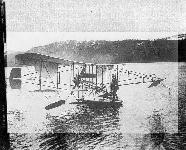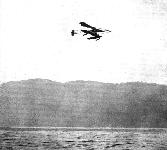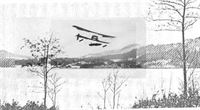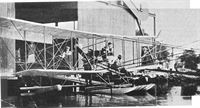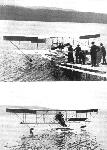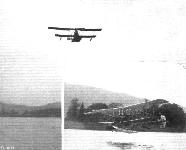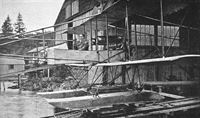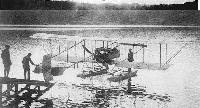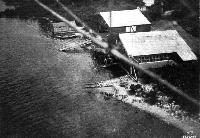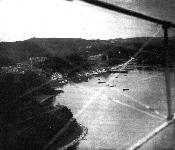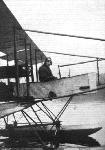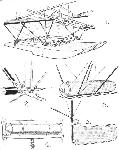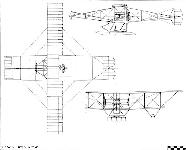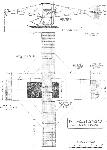A.Jackson Avro Aircraft since 1908 (Putnam)
Avro Curtiss-type
In the summer of 1910 A. V. Roe and Company declared its willingness to build aeroplanes to other people’s designs and the first such aircraft was a Farman-type biplane for the Bolton business man and manufacturer of Avro aero engines, Maurice F. Edwards. Bolts, fittings and bracing wires were also supplied to Miss Lilian Bland who built and flew the Mayfly biplane of her own design at Carnamony, Belfast. Each of these aircraft was fitted with one of the few examples of the 20hp two-cylinder, horizontally-opposed, air-cooled Avro engines. The Farman-type evidently did not met with much success as 18 months later, at the end of 1912, the engine and airframe were advertised for sale in new condition for £45 and £60 respectively.
A Curtiss-type, of the familiar outrigger-tail and front-elevator variety with 50 hp Gnome rotary, was built in 1911 to the order of Capt E. W. Wakefield of Kendal. Neither this nor the Farman-type mentioned above was given an Avro designation. Mainplanes were of unequal span and lateral control was by four ailerons on the upper mainplane, the inner and larger pair having semi-circular trailing edges. It was built at Manchester and delivered at Brooklands for test flying on May 25, 1911, though it did not fly until June 19.
After a short period with the Avro School during which it was flown by F. P. Raynham, R. C. Kemp, F. Conway-Jenkins and Louis Noel, the Avro-Curtiss was dismantled on July 7, 1911, and transferred to Lake Windermere where Capt Wakefield replaced the wheels by a single 12 ft, three step, canvas covered mahogany float built by Messrs Borwick and Sons of Bowness-on-Windermere and small cylindrical floats were fitted below the wingtips. During the course of the re-erection and modification much dissatisfaction was expressed with the standard of the machine’s construction and over the discovery of a crack below one cylinder of the Gnome engine. Legal proceedings were begun against A. V. Roe and Company with Capt Wakefield claiming £212 for the engine and £50 on account of the Curtiss-type not being built to contract but there was no recorded outcome to the case. The aircraft made its first flight in marine form on November 25, 1911, piloted by H. Stanley Adams, a former pupil of the Avro School. The success of the first test flights prompted Wakefield to invite the press to view an exhibition flight two days later. The event was reported at some length in The Westmoreland Gazette and the reference to the machine’s bird-like properties are thought to have prompted the adoption of the name ‘Lakes Water Bird’ by which the machine was subsequently known. Water Bird was the first consistently successful seaplane in the United Kingdom and during the next few months its fame spread quickly and a considerable waterborne joyriding business was done. Sixty flights were made in the first 38 days, the best being of 20 minutes duration up to a height of 800 ft. On December 7, 1911, Stanley Adams flew the whole length of the lake at a speed of approximately 40 mph at a height of between 60 and 100 ft. These operations continued throughout the winter, but the night of March 29-30, 1912, brought gales which demolished the lakeside hangar at Cockshott and damaged Water Bird beyond repair. Its float, tailplane and rudder (the last still proudly displaying the legend ‘A.V. Roe and Company, Manchester’) are still in the possession of the Wakefield family at Windermere.
Water Bird’s successor, identical, but entirely designed and built at Windermere by Capt Wakefield’s Lakes Flying Company later in 1912, was known as Water Hen. Its only Avro component was the airscrew and at first it could be distinguished from its Avro-built forerunner by the wingtip floats and straight trailing edges to the ailerons. These were mounted parallel to the chord line of the mainplanes instead of at a considerable angle to it. They were later remounted in the angled position but by that time more drastic modifications had been made and all similarity to Water Bird ceased.
SPECIFICATION AND DATA
Manufacturers: A. V. Roe and Company, Brownsfield Mills, Great Ancoats Street, Manchester; and Brooklands Aerodrome, Byfleet, Surrey
Power Plant: One 50 h.p. Gnome
Dimensions:
Span (upper) 41 ft. 0 in. (lower) 32 ft. 0 in.
Length 36 ft. 5 in. Wing area 365 sq. ft.
Weights: Tare weight 780 lb. All-up weight 1,130 lb.
Performance: Maximum speed 45 m.p.h. Ceiling 800 ft.
Production: One aircraft only, first flown as landplane 6.11; first flown as seaplane 25.11.11, damaged beyond repair at Cockshott, Windermere 30.3.12
Показать полностью
H.King Aeromarine Origins (Putnam)
Among the earliest and most fervent of British 'water fliers' was Mr E. W. Wakefield, who, in 1911, formed the Lakes Flying Company at Cockshott, Windermere, Westmorland. A letter he sent to Flight early in 1912 has its own story to tell:
'Canon Rawnsley has written to The Times and several other papers a poetic appeal calling on all lovers of the English Lakes to rise and protest against this new invasion of the charms of Windermere.... He does not tell you of the country's need for more trained flying men, and of better and more diverse machines; or how the United States Navy have adopted hydroaeroplanes, or how Germany and Holland are inquiring all about the new machine which he is so anxious to wipe off Windermere. He does not tell you that almost everyone who has seen it flying agrees that it adds to the great natural beauty, like a fine bird, between water and sky in the changing lights.'
The aircraft which inspired this impassioned protest was the Waterbird, a Curtiss-type floatplane built by A. V. Roe. It was initially flown from Windermere on November 25, 1911 - only one week after the first British take-off from water by Cdr Oliver Schwann.
Показать полностью
M.Goodall, A.Tagg British Aircraft before the Great War (Schiffer)
Deleted by request of (c)Schiffer Publishing
AVRO Curtiss type biplane
This aircraft, ordered by Capt. E. W. Wakefield of Kendal, was built in 1911 at Manchester and then transferred to Brooklands, where it flew on the 19 July 1911 as a land-plane. After completion of flight tests it was delivered to Lake Windermere and fitted with a single central float and cylindrical floats below the lower wing tips, flying for the first time in this form on 25 November 1911. The machine was the subject of criticism and legal action by Wakefield against A.V. Roe and Co., but operated successfully until the following year under the name of Lakes Water Bird (q.v.).
LAKES FLYING Co. (Capt. E.W. Wakefield of Kendal and H. Stanley-Adams. Hangars at Hill of Oaks and Cockshot, Windermere, Cumberland)
This company, financed by Wakefield, was formed in December 1911 to run a seaplane flying school, for passenger carrying and for aircraft construction. Prior to forming the company Wakefield ordered an aircraft from A.V. Roe & Co. (q.v.). This machine became known as the Lakes Water-Bird. The company was taken over by the Northern Aircraft Co. on 11 November 1914.
LAKES seaplane Water-Bird
The aircraft built by Avro was of typical Curtiss design, with front elevator and single rudder, and tailplane carried on tapering bamboo booms. The wings were of unequal span, the upper carrying four single ailerons, the inboard being of wider chord and with curved trailing edges.
The machine was flown for the first time, as a land-plane at Brooklands, by R.C. Kemp on 19 June 1911, followed by other pilots, before it was transferred to Windermere. Once there, a three step central float with canvas top, made by Borwick and Sons of Bowness, was fitted, together with cylindrical canvas wing tip floats. In this form it flew in the hands of Stanley-Adams on 25 November 1911.
The long delay before the machine was flown was mainly caused by Wakefield's criticism of the engine, which was secondhand and had to be sent back to France to be reconditioned, but also because of some constructional problems in the airframe. The aircraft was damaged beyond repair at Cockshot Point, when the hangar was destroyed by a gale on 30 March 1912.
Power: 50hp Gnome seven-cylinder air-cooled rotary driving a 8ft 6in diameter propeller.
Data
Span top 41ft
Span bottom 32ft
Chord 5ft
Length 36ft 5 in
Main float 12ft long 2ft beam 1ft deep
Wing tip floats 3ft long 8in diameter with springboards below
Area 365 sq ft
Weight 780 lb
Weight allup 1,130lb
Speed 33-45 mph
Ceiling 800ft
One aircraft built at Manchester by A. V. Roe & Co.
LAKES seaplane Water-Hen
The Lakes company built a copy of the Water-Bird, incorporating various modifications, and named it Water-Hen. The changes included a single pair of parallel chord ailerons and a tail elevator. To cater for passenger carrying a larger central float with a single step, and with aluminum sheet covering of the bottom and sides, was again made by Borwicks. An enclosed nacelle with pointed front was fitted, to protect the crew, in the winter of 1912-1913.
Adams flew the Water-Hen for the first time on 30 April 1912 and it continued in use for passenger carrying and training work until well into 1916.
Later a longer nacelle with curved front was fitted and subsequently, twin widely spaced floats; at the same time the wingtip floats were removed. A water rudder was fitted below the rudder briefly, but was not effective. One aircraft only was built.
Data as for Water-Bird except for the following information from Flight.
Data
Span top 42ft
Area 375 sq ft (Quoted incorrectly in Flight as 270 sq ft)
Area tailplane 11 sq ft
Area rudder 9 1/2 sq ft
Area rear elevator 6 1/2 sq ft
Area front elevator 17 1/2 sq ft
Main float 12ft long 6ft beam 1ft deep
Показать полностью
P.Lewis British Aircraft 1809-1914 (Putnam)
Lakes Waterbird
The Waterbird was a two-seat pusher hydro-biplane of unequal span built during the summer of 1911 by A. V. Roe and Co., for Captain E. W. Wakefield of the Lakes Flying Co., Lake Windermere, Westmorland. A Curtiss-type float with three steps was fitted, and consisted of a fabric-covered frame of mahogany; the float was made by Borwick and Co., of Windermere. The ailerons were hinged from the trailing-edge of the upper wings and were inset from the wing-tips. The engine used was a 50 h.p. Gnome.
Prior to the fitting of the floats, the machine was tested at Brooklands during May, 1911, with a land undercarriage. The Waterbird was flown from Lake Windermere on 25th November, 1911, and afterwards by H. Stanley-Adams, earning for itself the distinction of being the first entirely successful British seaplane designed as such.
Lakes Waterhen
The Waterhen was constructed early in 1912 and was the outcome of Captain E. W. Wakefield's studies made at the flying-schools at Brooklands and Hendon. His conclusions were that it was safer to crash into water than on unyielding ground, especially after witnessing the crashes at the 1909 Blackpool Meeting, and also that an aircraft with a comparatively slow operating speed gave greater safety and comfort for the crew. The machine was intended as an improved version of the 1911 Waterbird, which had been built by A. V. Roe for training at Wakefield's Lakes Flying Company school at Cockshott, Lake Windermere, and which had proved itself to be a successful trainer.
Oscar T. Gnosspelius was the designer of the new hydro-biplane, which was a two-seat pusher with the crew seated in tandem on seats set at an angle. Gnosspelius paid particular attention in the design to ensuring a good take-off at low speeds and, with this end in view, the wings-which were made by A. V. Roe and Co. - incorporated a deep camber for their high-lift section. Bamboo out-riggers fore-and-aft carried the control surfaces, a bamboo pole connected to the top of the joy-stick operating the front elevator. Split ailerons of constant-chord were replaced later by one-piece surfaces.
A single central stepped float, much broader than that of the Waterbird, was fitted on a flexible suspension system of rubber shock cord and was provided with an aluminium bottom, duralumin sides and a top of Willesden canvas. Air-sacks, fitted with spring-board protectors underneath, functioned as wing-tip floats. The engine fitted was the ubiquitous 50 h.p. Gnome rotary, driving a two-bladed propeller, 8 ft. 6 ins. in diameter and made by A. V. Roe and Co.
The Waterhen was tested by H. Stanley-Adams on 30th April, 1912, and commenced its flying career with the Lakes Flying Company on 3rd May, 1912, after which it was making trips daily over Windermere. During the first seven months it completed some two hundred and fifty flights and carried over one hundred different passengers on joy-trips piloted by Stanley-Adams. On 12th November, 1912, Lt. J. F. A. Trotter gained Royal Aero Club Aviator's Certificate No. 360 with the machine at Lake Windermere after training with the Lakes Company; the firm later changed its name to the Northern Aircraft Company.
After a considerable amount of very successful flying had been carried out, the Waterhen was modified. Enclosed seating for the crew was provided by fitting a nacelle for them, and the single float was replaced by twin floats, which, at the same time, resulted in the removal of the air-bags under the wings. In this form the machine continued in use after the outbreak of the 1914-18 War and gave good service as a trainer at Windermere for the R.N.A.S.
SPECIFICATION
Description: Two-seat pusher hydro-biplane. Wooden structure, fabric covered.
Manufacturers: Lakes Flying Company, Cockshott, Lake Windermere, Westmorland; wings by A. V. Roe and Co., Manchester; floats by Borwick and Sons, Cockshott, Lake Windermere.
Power Plant: 50 h.p. Gnome.
Dimensions: Span, 42 ft. Length, 36 ft. 5 ins. Wing area, 365 sq. ft.
Weights: Empty, 780 lb. Loaded, 1,130 lb.
Performance: Maximum speed. 45 m.p.h. Landing speed, 33 m.p.h. Ceiling, 800 ft.
Показать полностью
J.Bruce British Aeroplanes 1914-1918 (Putnam)
Lakes Flying Go. (later N.A.G.) Water Hen
CAPTAIN E. W. WAKEFIELD was one of the little-known pioneers of aviation in England. As early as 1909 he publicly expressed his belief that, in the state of aeronautical knowledge at that time, the best type of aircraft to develop would be one capable of rising from and alighting on water. Such a machine, he argued, would be less susceptible to the type of damage so frequently sustained by contemporary aeroplanes.
Wakefield’s ideas were scorned, but his faith in the seaplane was soon vindicated by the successful flights made by Henri Fabre’s “hydro-aeroplane” at Monaco and, later, by Glenn Curtiss in America. The Curtiss aircraft was a biplane fitted with a central-float undercarriage.
Captain Wakefield and a few friends formed the Lakes Flying Co. in 1911 and commissioned A. V. Roe to build a centre-float seaplane generally similar to the Curtiss machine. The aeroplane which was built against this order was known as the Waterbird, and had a single narrow float mounted centrally. Although reasonably efficient, the Waterbird did not come up to expectations: it was flying in November, 1911, and had the distinction of being the first successful British aircraft to be designed as a floatplane from the beginning.
Meantime, representatives of the Lakes Flying Co. had been studying developments in the design and construction of aeroplanes. They applied their knowledge to the design of a new floatplane, which was completed by the spring of 1912.
The new aircraft was named Water Hen. It was an unequal-span pusher biplane with both front and rear elevators; the engine was a 50 h.p. Gnome rotary. The first float to be fitted to the Water Hen was 12 feet long and 6 feet in beam, and was made by Borwick & Sons, a firm of boat-builders of Bowness-on-Windermere. It was made of mahogany and canvas, and had three steps. An improved single-step float was later fitted; it had silver spruce frames and three longitudinal bulkheads. The planing bottom was covered with aluminium, the sides with duralumin, and the top with Willesden canvas. The float was connected to its attachment frame by means of rubber cord. Stability on the water was ensured by two small air sacks, one mounted under each lower wing.
The Water Hen was designed to be a slow-flying aircraft, for it was intended to have a low take-off speed and to be able to lift a passenger easily. The passenger sat high up between the wings, and the pilot’s seat was lower down, immediately in front of the lower wing. There was no protection of any kind for either occupant.
The aircraft was an instant success, and its basic design was little altered throughout its long career. The fitting of the improved float has been mentioned, and subsequent modifications were of a similar nature.
The Water Hen was used at Lake Windermere as a joy-riding machine, and flew with a regularity which was outstanding for the time. By the beginning of December, 1912, it had made 250 flights and had carried 100 passengers during the seven months it had been in existence.
The Water Hen was still flying when war broke out, by which time it had been modified by the addition of a small nacelle to protect the pilot and passenger, whose seats had been suitably re-aligned; and the big central-float had been replaced by two separate pontoon-type floats. When this last modification was made the wing-tip floats were removed.
The Lakes Flying Co. was succeeded by the Northern Aircraft Co., who continued to operate the Water Hen. A number of R.N.A.S. seaplane pilots received their initial instruction on this veteran seaplane, which continued to fly until 1916 as if in vindication of Captain Wakefield’s belief in the usefulness and safety of floatplanes.
SPECIFICATION
Manufacturers: The Lakes Flying Co., Cockshott, Windermere (float made by Borwick & Sons, Bowness-on-Windermere).
Power: 50 h.p. Gnome.
Dimensions: Span: upper 42 ft, lower 32 ft. Length: 36 ft 5 in. Chord: 5 ft. Gap: 5 ft. Stagger: nil. Span of tail: 6 ft 10 in. Span of forward elevator: 6 ft 10 in. Airscrew diameter: 8 ft 6 in.
Areas: Wings: 365 sq ft. Tailplane: 11 sq ft. Elevators: rear 6-5 sq ft, front 17-5 sq ft. Rudder: 9-5 sq ft.
Weights: Empty: 780 lb. Loaded: 1,130 lb.
Performance: Maximum speed: 45 m.p.h. Ceiling: 800 ft.
Показать полностью
Jane's All The World Aircraft 1913
LAKE FLYING Co. Windermere. Established 1911, by E.W. Wakefield, with a view to hydro-aeroplane experiments. The first machine was a Curtiss type built by A.V. Roe, which flew in November, 1911. In 1912, a special biplane generally of Farman type but with more camber to the planes, was built.
Length.--36-1/2 feet (11 m.) Span.--42 feet (12.80 m.) Area.--270 sq. feet (25 m.?) Motor.--Gnome.
Speed.--45.33 m.p.h. (72.54 k.p.h.)
The single float is 6 feet wide, flexibly connected. Balancers mounted on a spring board. Water rudders for steering at slow speed. Fuller details see Flight, December 7th, 1912. Early in 1913, an Avro was purchased for further experiments.
Показать полностью
Журнал Flight
Flight, June 8, 1912.
Good Progress with the "Water Hen."
LAST week some very fine flights were made by Mr. Stanley Adams on Mr. Wakefield's hydro-biplane over Lake Windermere, and regular passenger trips are now being carried out On Monday week seven passengers, including two ladies, paid their fees, and were carried for trips over the lake. Although the wind was gusty on Tuesday and Wednesday, further passenger voyages were carried out, and on Thursday Mr. Adams made a solo flight to Bowness and Waterhead, alighting on the water at the latter point. A stop was also made at Henholme, on the way back to Hill of Oaks. The visit to Bowness was arranged in connection with the annual sports, and the spectators were greatly interested in the evolutions of the "Water Hen" over the lake. About 22 miles were covered altogether.
Flight, December 7, 1912.
THE "WATER HEN".
THIS interesting hydro-biplane, which has been flying almost daily throughout the past year over Lake Windermere, may be said to have originated at Blackpool way back in 1909. This, perhaps, seems rather curious, since as far as our mind takes us back, power-driven flying machines to rise from water were scarcely even dreamt of at that time. It happened in this way. Most of those who now constitute the Lakes Flying Company were present at that memorable meeting. One of their number, Mr. E. W. Wakefield was more than usually struck by the amount of damage that was done through a machine, its pilot, or both, hitting solid ground. It occurred to him that if a machine could be made to rise from and alight on water and remain for the whole time over that liquid element, the chances of fatalities arising from accidents could be most effectively and materially reduced.
But at that time everyone was sceptical. The whole thing was impossible! It stood to reason that the friction and resistance of a hydroplane-float skimming over water would be infinitely greater than that of wheels running over ground. Further than that, as soon as the motor was started, would not the thrust of the propeller, necessarily high up between the planes threaten to push the nose of the float under water?
But, nothing daunted by general adversity of opinion, Mr Wakefield and a few of his personal friends decided, at any rate, to make a sporting effort at producing a successful water flying-machine. The experiments of M. Henri Fabre, at Monaco, with his extraordinary hydro-monoplane, and those of Glen Curtiss, in the United States of America, with his float-equipped biplane, were closely followed, and they taught many lessons. Then, again, Mr. Oscar Grosspelius had constructed a Bleriot-type monoplane on a broad float, which, being underpowered, had not, at that time, been successful in getting off the water. From it also many invaluable lessons were learnt, and so, having collected and tabulated a goodly collection of data by the summer of 1911, Mr. Wakefield commissioned Messrs. A. V. Roe and Co. to build for him a biplane of the Curtiss type. This was fitted with a single narrow float, much after the same style and shape as that fitted to the Curtiss machines in America. It, however, embodied several improvements that had resulted from the independent experiment.
Although, unfortunately, the machine itself was not quite as efficient a flyer as it was hoped, it nevertheless succeeded admirably as far as things went. It was flying freely during November, 1911, and had the distinction of being the first successful British hydro-aeroplane.
Meantime, representatives of the Company had been studying how things went on at Brooklands and Hendon, and, having picked up as many tips in construction as they could assimilate in the time, they returned to headquarters. As a result the biplane that we are describing in this issue came into existence. It was purposely designed to be a slow-flying machine in order that it might lift from the water at a low speed and be more comfortable for passenger carrying. The float fitted was of a new type, much broader and was stepped. The intended results were achieved at the first trial, and the machine has remained practically unaltered from that day to this.
During the seven odd months it has been in use over Windermere, it has made about 250 flights, and has carried over 100 different passengers.
As can be remarked from the photographs and sketches that accompany this brief description, the machine does not depart, in any great respect, from what is nowadays considered conventional practice. It has a Farman type of cellule, but the camber of its wings is considerably more marked than in that machine in order that it may lift all the more readily at slow speeds. The tail at the rear and the elevator in front are supported by triangular bamboo outriggers, and these surfaces are controlled from the pilot's seat by a typically Farman universal lever. Balancing is also carried out by the Farman system of aileron flaps.
The biplane has a speed range of from 33 miles to 45 miles per hour.
Undoubtedly the most interesting part of the whole machine is the gear that enables it to land and start off from water, for it must be remembered that at the time the machine was constructed, very little exterior knowledge of the subject was available. Unlike most water flying machines of to-day a flexible suspension is provided so that the float itself will not form too solid an abutment against the hammering of the waves. One of our sketches shows this point clearly. The float is built upon a latticed skeleton of silver spruce having three longitudinal bulkheads. Aluminium covers the bottom of the float, duralumin the sides, and Willesden canvas the top.
It may fairly be asked whether this type of float and undercarriage is equally well adaptable to aeroplanes other than of the type that it was originally designed for.
The Lakes Flying Company maintain that, excepting for minor modifications, their design of undercarriage can in every case be successfully used to convert a land flying machine into a water flyer. This, to some extent, they have themselves proved, for similar floats fitted to a monoplane and a tractor biplane have given every satisfaction in use. They had a share in producing, we believe, the first hydro-monoplane to lift passengers.
With a single float, balance naturally became necessary. Following on numerous tests, the "Water Hen" was fitted with simple air sacks mounted on springboards, and they have proved so serviceable that there has been no reason to change them.
Mr. Wakefield is characteristically modest when talking about the machine he has developed throughout these past three years. He claims that if the machine has done nothing else, it has at least proved his contention that it is better to get a ducking than to get badly smashed up. But, although he does not make a song about it, we know he has gone considerably farther than that.
Flight, August 2, 1913.
WATER FLIGHTS AT WINDERMERE.
MR. STANLEY ADAMS is giving visitors to Windermere this year a very great deal of additional enjoyment by his able flying of the "Waterhen" and the more recently built tractor biplane that was described in FLIGHT the other week. Those anxious to enjoy passenger flights over the lake are numerous, and business on a fine day is brisk; besides, Mr. Adams is a cautious pilot, and gives confidence to the spectator. The surroundings of Windermere are beautiful to the eye, but from the pilot's point of view they often have an ominous look, for awkward eddies are not infrequent, and the more ideal the day from the visitor's standpoint the less sometimes is the air in a good state for flying.
Last Saturday Mr. Adams did good service in the enthusiasm he aroused among members of the automobile industry in Lancashire and district who had come down at the invitation of Sir Kenneth and Lady Crossley to enjoy the afternoon at Pull Woods. When the "Waterhen" appeared, all other interests were forgotten, and the booking for flights ultimately kept the steamer waiting at the pier head for a quarter of an hour or more while the last on the list made his trip aloft.
How long, we wonder, before the private air yacht daily spreads its wings in graceful flight above the lake? A silent engine and no castor oil would do more than most things to bring it to pass.
Показать полностью


